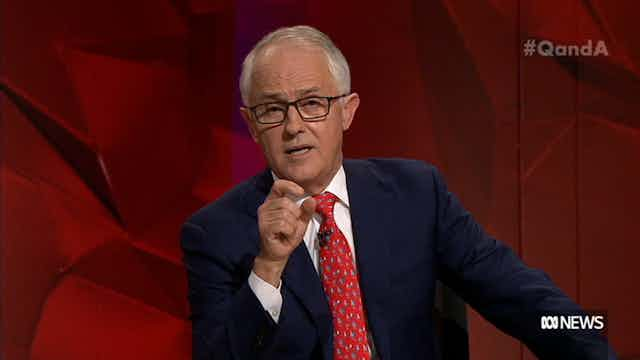Conservatives are currently obsessed with identity politics.
Almost every issue of The Australian comes with a fusillade against the ways identity politics threaten civic discourse. And a Financial Review editorial in September warned:
… thoughts, expression and questioning are now more likely to be silenced in the excess of identity politics, where race, gender, sexuality and group-think declarations have replaced class as the key political dividers.
Yet one of the worst examples of identity politics came from Prime Minister Malcolm Turnbull in his Q&A appearance on December 11. In opposing the idea of an elected Indigenous Advisory Council, he claimed that politicians such as Ken Wyatt and Linda Burney represent Indigenous Australians. In fact, they represent the electors of Hasluck and Barton – few of whom are Indigenous.
It is great that there are Indigenous politicians in parliament (Turnbull somehow forgot the two Labor senators, Pat Dodson and Malarndirri McCarthy). But they are not there to “represent” Indigenous Australians any more than Mathias Cormann is there to represent Belgian-Australians.
Political party identities
The primary identity of politicians in our system is their political party. Sometimes other identities will seem more important, as in the case of the four openly gay Liberal MPs who pushed their party toward a free vote on marriage equality, or Michael Danby’s support for Israel – which goes far beyond the views of his party.
What these cases suggest is the complex and overlapping nature of identities, and the trap of defining anyone by only one identity. Nor does belonging to a particular group, whether through race, ethnicity or gender, mean one automatically speaks “for” that group. Margaret Thatcher or Bronwyn Bishop never sought to speak “for women”.
Identity politics, as we understand them, are often assumed to have emerged from the women’s, black and gay movements in the early 1970s. There is an earlier history, linked to the development of nationalist movements in 19th-century Europe, and the growth of anti-colonial movements across European empires.
Identity politics are born when people feel excluded because of something important to their sense of self – whether it be race, gender, sexuality or language. But they are also thrust upon people, as in the tragic case of those Jews who believed themselves to be 100% German until the Nazis came to power.
A sense of a shared history is crucial to empowering people who have been oppressed, and sometimes made invisible. When I was a schoolboy in Hobart we were taught that there were no Tasmanian Aborigines, who had effectively been wiped out by settlement. Today more than 4% of the state’s population identify as Indigenous.
Not necessarily born this way
Conservatives are particularly disturbed by the idea that gender identities might be fluid, which seemed their central concern in the marriage equality debate.
Ironically many of those who defend ideas of gender fluidity also believe their sexual identity is, in Lady Gaga’s words, “born this way”. In both cases the rhetoric ignores the evidence of both history and anthropology.
Identity politics are neither inherently left nor right. Some Marxists denounced the new social movements as threatening class unity, in terms rather like those who now see identity politics as fracturing a common polity.
One of the common criticisms of Hillary Clinton’s US presidential campaign was that she spoke too often to specific groups, rather than in the language of inclusion. This is an odd argument given Donald Trump’s blatant attacks on Hispanics and Muslims, which were clearly an appeal to white Americans who felt their identities were under threat.
Most critics of identity politics speak as if they were above identity, when in practice their identities are those of the dominant group. Pauline Hanson excludes Aborigines, Asians and Muslims from her view of Australian identity, cloaked in the language of patriotism.
Like Hanson, those who attack identity politics are often most zealous in defending their own versions of identity. Current proposed changes to citizenship requirements are supported by an emphasis on “Australian values”, as if these are both self-evident and distinguishable from more universal values of political and civil rights.
On the same Q0&A program Turnbull defined Australian values as based upon “multiculturalism”, which acknowledges that contemporary society is a mosaic of different and overlapping identities and communities. It is possible to argue that respect for cultural diversity is a national value, while ignoring the question whether Australian law treats all cultural values equally.
In practice, cultural diversity is clearly subordinate to a legal and political system heavily based on British precedents. A genuine multicultural identity might start by extending the term “ethnic” to include people of British ancestry, as much an “ethnicity” as any other.
Identity as a means of exclusion
Identity politics threaten democratic debate when they become a means of shutting down any comment that does not grow entirely out of experience.
Writers have been criticised for creating characters who do not share their author’s race or gender; speakers shunned for expressing views that are deemed “insensitive”.
Writer Germaine Greer may have views on transgender issues that should be opposed. But they should be met with rebuttal, not a refusal to listen. Critics of identity politics are right that zealousness in protecting identities can itself become repressive.
Identity politics become dangerous when they become an argument for exclusion.
Unfortunately, the most dangerous examples of exclusion come from those who clam to speak for “the people”, a term which itself depends upon a certain version of identity. The populists who attack identity politics do so while creating their own, limited image of national identity.

